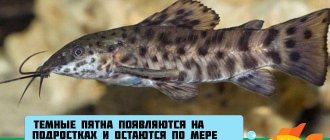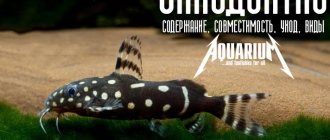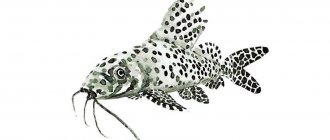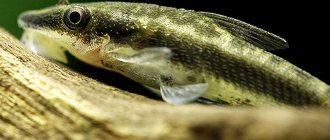Tool for combing the hair of cats and dogs My Rules (deshedder, comb, slicker) size M
711 ₽ More details
History of Russia for children. Book Butromeev V.P. | Butromeev Vladimir Petrovich
888 ₽ More details
Dog collar
There is a huge variety of catfish species in the world, most of the small specimens have long been loved by aquarists. Not long ago, the cuckoo catfish, or polyspotted synodontis, joined the ranks of everyone’s favorites. This species is distinguished by its attractive bright colors and interesting character and habits.
The cuckoo catfish is distinguished by its attractive bright color and interesting character and habits.
Habitat in nature
This small catfish lives in Lake Tanganyika (Africa). To raise offspring, Synodontis multispotted uses nest parasitism. This is the same principle that the common cuckoo uses when laying its eggs in other people's nests.
Only in the case of the cuckoo catfish, it lays eggs in the clutches of African cichlids.
It has a specific purpose - cichlids brood their eggs in their mouths. At the moment when the female cichlid lays eggs, a pair of catfish prowls around, laying and fertilizing their own. In this chaos, the cichlid takes both its own eggs and those of others into its mouth.
This behavior was even studied by scientists at the University of Colorado in Boulder (USA). They concluded that synodontis eggs develop faster, larger and brighter than cichlid eggs.
And this is a trap for cichlid larvae, which hatch at the moment when the catfish fry begin to feed. As a result, they become starter food. If all the cichlid fry are destroyed, the catfish begin to eat each other.
In addition, catfish have another advantage. Those eggs that were not collected by the cichlid still develop.
When the fry swims, it waits for the moment when the female releases her fry from her mouth. The young cuckoo then mixes with the cichlids and enters the female's mouth.
Now do you understand why it is called the cuckoo catfish?
Features of catfish spawning
According to its biological behavior, the synodontis cuckoo catfish is a nest parasite, therefore it is indifferent to its offspring. If only representatives of this species live in the aquarium, then they most likely will not reproduce successfully.
Therefore, breeders also place other fish with well-developed maternal instincts in the container. Under artificial conditions, synodontis can adapt to the spawning period of almost any fish, but in natural conditions a cichlid usually becomes the “nanny” for its fry.
The cuckoo catfish has a unique biological mechanism that allows it to calculate the beginning of the mating season of these fish and produce small portions of eggs in its body for the so-called adaptation. Cichlid spawning lasts only 1 hour, so it is very important for synodontis to get within this time period.
The catfish reaches sexual maturity by the age of two. The reproduction process can be stimulated by creating special conditions :
- In the aquarium, it is necessary to maintain the temperature at 25 °C, hardness - 10 ̊, acidity - pH 7. In the natural environment, the spawning period begins with the beginning of the rainy season; at home, you can simulate this moment by lowering the temperature by 2-3 degrees from normal.
- Change the water frequently - every 2-3 days. Half of the total water volume must be replaced.
Cichlid spawning lasts only 1 hour, so it is very important for synodontis to get within this time period.
The cuckoo catfish is one of the few representatives of synodontis that successfully reproduce in captivity. Other species, such as shifter catfish, broadmouth catfish, flag catfish, marbled catfish and veil catfish, cannot produce eggs in a home environment without additional hormonal injections.
Egg laying occurs as follows. Seeing cichlids spawning, female synodontis begin to rush past them, simultaneously throwing eggs. After the process is completed, the cichlid collects its eggs into the oral cavity, but it does not do this very carefully, so grains of sand and other particles, as well as catfish eggs, which are much smaller in size than its own, fall with them. This is how the incubation process begins.
Small catfish hatch a little earlier than cichlids and at first feed on their eggs, so only they remain alive. The cichlids keep the Synodontis fry in their mouth for some time, but they are much larger than their own. In this situation, cichlids practically do not have time to reproduce, so catfish, parasitizing, destroy their offspring. Therefore, in order to preserve the domestic population, it is recommended to periodically place a pair of cichlids before spawning in another aquarium for the safe hatching of their fry.
Synodontis babies are fed 4 times a day with live dust, artemia, daphnia, and nematodes. They grow quite quickly.
Description
Synodontis multipunctatus is one of the many catfishes found in Lake Tanganyika. It lives at depths of up to 40 meters and is capable of gathering in large schools.
In nature it can reach 27 cm, but in an aquarium it rarely reaches a body length of 15 cm. Life expectancy is up to 10 years.
The head is short, slightly flattened on top and strongly compressed on the sides. The eyes are large, making up up to 60% of the size of the head. The wide mouth is located at the bottom of the head and is decorated with three pairs of fringed mustaches.
The body is massive, strongly compressed laterally. The dorsal fin is relatively small, with 2 hard and 7 soft rays. The adipose fin is small. Pectoral fins with 1 hard and 7 soft rays.
The color is yellowish with numerous black spots. There are no spots on the belly. The back of the fins is white and blue. The tail has a black edging.
Who can I combine with?
Speaking about compatibility with other fish, based on the experience of experienced aquarists, synodontis gets along best with species such as lalius, aulonocara, Jackson's haplochromis, rainbow fish - melanotenia, angelfish and Mbuna cichlids - relatives of catfish in their native African lakes. Synodontis is considered a peace-loving, quite intelligent and sociable fish. Owners of catfish that live next to a person for a long time can stroke their pets’ tummy, and often notice an attentive gaze directed at themselves when they are about to feed their charges. However, if a fish has settled in the aquarium, leading the same lifestyle as a catfish, then conflict is not far away. Therefore, it is worth choosing neighbors for such an unusual and cute predator more carefully.
See below for information on keeping a catfish.
Content complexity
Not a difficult and unpretentious fish to keep. But this catfish is very active even during the day and can disturb other fish at night. In addition, like all catfish, it will eat any fish it can swallow.
Its neighbors may be fish larger than it or of equal size. As a rule, cuckoo catfish are kept in cichlids, where it is of greatest value.
Feeding
The cuckoo catfish is considered not only an omnivorous fish, but also an aquarium cleaner. He happily eats algae from the walls of the aquarium, worms, snails and, in some cases, even carrion.
For the full development of fish and further maintenance of its health, the animal’s diet should consist of 70% protein foods:
The rest of the menu is occupied by plant and dry food.
Dry food should only be purchased at pet stores. They must be designed specifically for catfish. The serving size and its composition are indicated on the packaging.
Multispotted synodontis are prone to overeating, and, as a result, obesity. You need to feed the fish once a day in the late afternoon (1 - 2 hours before the end of daylight). The serving size is determined by the amount that the flock can eat in 4 - 5 minutes. Next, the remaining food is caught and removed.
Keeping in an aquarium
It is unpretentious, but its size (up to 15 cm) does not allow it to be kept in small aquariums. The recommended aquarium volume is from 200 liters.
In the aquarium it is necessary to mark out shelters - pots, tubes and driftwood. The catfish will hide in them during the day.
It is worth noting that, unlike other catfish, the cuckoo is active during the day. However, if the light is too bright, they avoid appearing and hide in shelters.
Water parameters: hardness 10-20°, pH 7.0-8.0, temperature 23-28 °C. Powerful filtration, aeration and weekly replacement of up to 25% of water are required.
Synodontis diseases and their treatment
If all conditions are met, the cuckoo catfish will grow healthy, mobile and less susceptible to various diseases. If its behavior has changed and the synodontis has become sluggish and the color has faded, it is necessary to urgently review the diet, as well as the composition of the water, its acidity and temperature.
In addition, the poor health of the fish can be caused by stressful situations, which can be provoked by a lack or uneven distribution of food between individuals of the school, an insufficient number of shelters, which will lead to the development of conflict situations between catfish, as well as changes in water parameters.
In any case, it is necessary to find out the causes of the fish’s illness as soon as possible and eliminate them. In addition to being susceptible to stress, synodontis are prone to accumulating fat deposits. If the breeder notices that the fish has gained more weight than necessary, he can arrange weekly fasting days , this will help normalize body weight without harm to the catfish.
In addition to being susceptible to stress, synodontis are prone to accumulating fat deposits.
Sometimes you can observe a situation where a cuckoo catfish falls over on its side and begins to breathe convulsively. This indicates insufficient oxygen saturation of the water. To correct the problem, you need to check the aeration.
Due to the fact that the catfish lives primarily in the lower layers of the water reservoir, it may develop a disease such as fin rot . For treatment, prepare a separate vessel with streptocide diluted in water, into which the catfish must be immersed for half an hour.
Any violation of the usual way of life promises troubles for the health of the fish, and can even cause the development of serious diseases. Therefore, it is necessary to carefully monitor the conditions of keeping the cuckoo catfish - proper feeding, arrangement of the aquarium, stability of the water composition and quality of diffused lighting.
These catfish are considered unpretentious - they are omnivores and get along with most aquarium fish. Therefore, it will not be difficult for novice breeders and hobbyists to keep them in home aquariums. The conditions for caring for them are quite standard, this type of fish is relatively hardy, and if treated well, catfish will please the owner with a long life of 15-20 years.
Compatibility
This synodontis is much more active during the day than other species. It is a fairly peaceful fish, but is territorial towards other synodontis.
The cuckoo catfish must be kept in a flock, otherwise a stronger individual may overwhelm a weaker one. The larger the flock, the less pronounced territorial aggression.
This catfish should not be kept with small fish, which it will eat during the night. It is ideal to keep it in a biotope with African cichlids, where it will be right at home. If the aquarium is of a mixed type, then choose neighbors larger than it or of equal size.
Is the cuckoo catfish male or female?
Adult females are plumper than males. Males have a taller body and a dorsal fin. In addition, gender can be determined by the genital papilla. It is located between the ventral fins. Males have a pointed papilla, while the female has a rounded one. The sex of most medium and large species of synodontis can be determined in this way, but it must be taken into account that individuals reach sexual maturity after 2 years.
Male cuckoo catfish (left) and female (right) (ill. monsterfishkeepers.com/forums)











